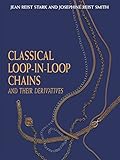Classical loop-in-loop chains and their derivatives [Libro electrónico] / Jean Reist Stark, Josephine Reist Smith
Por: Stark, Jean Reist [autor/a].
Smith, Josephine Reist [autor/a].
Tipo de material: Libro
en línea Editor: New York, New York, United States: Chapman & Hall, c1997Descripción: xviii, 190 páginas : ilustraciones ; 28 centímetros.ISBN: 0412078813; 9780412078811 (Print); 9781468491326 (Online).Tema(s): Jewelry making | Chains (Jewelry)Nota de acceso: Disponible para usuarios de ECOSUR con su clave de acceso Nota de bibliografía: Incluye índice: páginas 189-190 Número de sistema: 55536Contenidos:Mostrar
Resumen:
Libro
en línea Editor: New York, New York, United States: Chapman & Hall, c1997Descripción: xviii, 190 páginas : ilustraciones ; 28 centímetros.ISBN: 0412078813; 9780412078811 (Print); 9781468491326 (Online).Tema(s): Jewelry making | Chains (Jewelry)Nota de acceso: Disponible para usuarios de ECOSUR con su clave de acceso Nota de bibliografía: Incluye índice: páginas 189-190 Número de sistema: 55536Contenidos:Mostrar
Resumen:| Tipo de ítem | Biblioteca actual | Colección | Signatura | Estado | Fecha de vencimiento | Código de barras |
|---|---|---|---|---|---|---|
| Libros | Biblioteca Electrónica Recursos en línea (RE) | Acervo General | Recurso digital | ECO400555368259 |
Incluye índice: páginas 189-190
1. Origins and applications of loop-in-loop chains.. 2. General information.. 3. Single loop-in-loop chains.. 4. Pinched loop (sailor's chains.. 5. Double loop-in-loop chains.. 6. Multidirectional loop-in-loop chains.. 7. Multiple soldered loop-in-loop chains.. 8. Multiple woven meshes.. 9. Clasps and terminations.. Index
Disponible para usuarios de ECOSUR con su clave de acceso
This is not only a book of instruction in chainmaking but it is also a work celebrating man's continuous creativity over thousands of years. At times something that man creates has far-reach ing effects; an example that quickly comes to mind is the wheel, which has enabled many devel opments, from pottery to computers. At this point it is important to note that these same wheels could not have been made without metal tools. From early Neolithic times on gold was a favorite choice in the making of jewelry. During the Neolithic period these "shining stones," probably alluvial, were prized. Actually gold was cold worked as if it were a stone. There is a surviving example of cold-worked gold from Catahuyuk (present day Turkey) estimated to have been made in 6500 B. C. There were only four metals on the earth's surface that were found in sufficient quantity to be used: gold, copper, silver, and meteoric iron. An understanding of the malleability of gold, and of the annealing effect of fire, changed jewelry making; new forms were found. Gold was no longer a piece of stone but a material that could be flattened and made very thin. Sheet and foil are the oldest forms of worked gold. The smiths' tools were stone, wood, and horn. eng
Disponible en línea
Disponible en formato PDF
Subscripción a ELSEVIER 26 de diciembre del 2013
